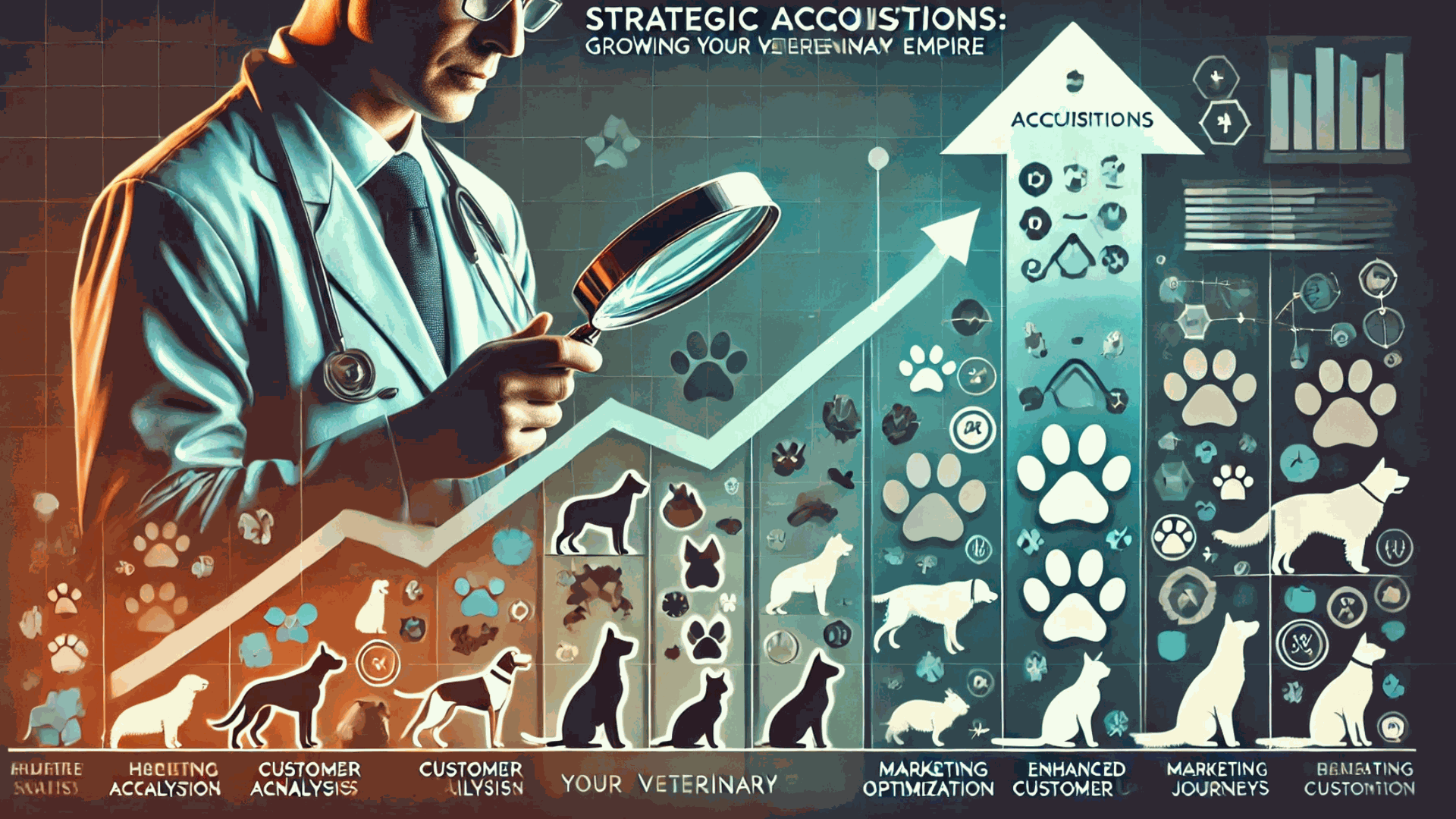
Executive Summary
Amid rapid consolidation in the veterinary sector, practice owners face a pivotal opportunity to expand their operations through strategic acquisitions. This guide adapts Vista Equity Partners' proven customer-centric acquisition strategy for veterinary practice owners. By focusing on high-value clients and operational excellence, practices can achieve sustainable growth and increased profitability through targeted acquisitions.
Introduction
Traditional veterinary practice acquisitions often focus solely on financial metrics, potentially overlooking crucial factors for long-term success. Vista Equity Partners revolutionised business acquisitions by prioritising customer value—a methodology particularly suited to veterinary practices, where client relationships directly impact long-term success. This approach ensures their acquisitions generate sustainable growth and value.
Understanding Customer-Centric Strategy
Vista's approach transforms standard acquisition practices by focusing on client value rather than just operational metrics. For veterinary practices, where long-term client relationships are crucial to success, this strategy proves especially powerful.
Key Principles Approach
- Customer Analysis Before making an acquisition, conduct a comprehensive analysis of customer histories and spending patterns to better understand client behaviour. This will identify high-value customers—those who stayed the longest and contributed the most revenue. Focusing on these loyal clients ensures you invest in a business with strong growth potential.
- Focusing on High-Value Customers the strategy prioritises acquisitions that reveal underserved, high-value customer segments. For veterinary clinics, this could mean targeting practices with a history of retaining long-term pet owners or offering specialised services like advanced diagnostics or surgical procedures.
- Eliminating Low-Value Channels Post-acquisition, the strategy streamlined operations by cutting channels that attracted low-value customers. This allowed them to reinvest resources into more profitable channels—an approach that veterinary practices can replicate by identifying services that attract high-value clients.
- Reverse-Engineering the Buying Process By studying the buying journey of high-value customers, strategies were developed to replicate those experiences for new clients. Veterinary clinics can similarly design customer experiences that mirror their most satisfied and loyal pet owners.
- Applying the Pareto Principle This approach embraced the Pareto principle, which states that 20% of customers typically generate 80% of revenue. By concentrating on this small but impactful segment, profitability was consistently increased.
Implementing Vista’s Strategies in Veterinary Acquisitions
Step 1: Conduct Customer Analysis
Evaluate the client base of the practice you’re considering. Use metrics such as average spending, visit frequency, and loyalty indicators to identify high-value customers. This analysis helps determine if the acquisition aligns with your growth goals.
Step 2: Optimise Marketing for High-Value Clients
Tailor your marketing efforts to attract pet owners who are likely to become high-value clients. Highlight premium services such as dental care, advanced imaging, or wellness plans that appeal to committed pet owners.
Step 3: Streamline Operations
Post-acquisition, eliminate low-value services or marketing channels that do not yield significant returns. Redirect resources to enhance offerings that attract and retain high-value clients.
Step 4: Enhance the Customer Journey
Study the onboarding process, communication strategies, and service touchpoints that resonate with high-value clients. Replicate and refine these elements to build long-term relationships with similar clients.
Step 5: Measure and Adjust
Regularly analyse key performance indicators (KPIs) such as client retention rates, average revenue per client, and customer satisfaction scores. Use these insights to continually refine your strategies.
Benefits of a High-Value Customer Focus
- Targeted Marketing Focusing on high-value clients enables precise targeting, ensuring your advertising dollars are spent on attracting the most profitable pet owners.
- Optimised Resource Allocation By investing in strategies that cater to high-value customers, you avoid wasting resources on low-return efforts.
- Increased Retention Rates High-value clients are more likely to remain loyal, reducing churn and ensuring steady revenue.
- Higher Profit Margins Catering to high-value clients allows for premium pricing and increased gross margins.
- Enhanced Customer Satisfaction When you focus on providing exceptional value to your best clients, overall satisfaction and referrals increase.
Challenges to Consider
While this strategy is effective, it demands disciplined execution. Misidentifying high-value customers or overinvesting in certain services can backfire. Regular reviews and data-driven adjustments are crucial to maintaining profitability and growth.
Conclusion
A customer-centric acquisition strategy can transform a veterinary practice into a thriving business. By identifying high-value clients, streamlining operations, and enhancing customer journeys, you create a sustainable model for growth. As you evaluate potential acquisitions, remember that quality always trumps quantity when it comes to building a loyal and profitable client base.
Frequently Asked Questions (FAQs)
- What are high-value customers in a veterinary context? High-value customers are pet owners who regularly visit the clinic, spend on premium services, and show loyalty over time.
- How can I identify high-value clients before acquiring a practice? Analyse the practice’s customer data, focusing on metrics like visit frequency, average spending, and retention rates.
- What services attract high-value customers? Advanced diagnostics, surgical procedures, wellness plans, and specialised care often appeal to high-value clients.
- Why should I eliminate low-value services? Low-value services can drain resources and detract from focusing on offerings that yield higher profitability.
- How can I replicate the buying journey of high-value customers? Study their preferences, communication habits, and service expectations, then design similar experiences for prospective clients.
- What is the Pareto principle, and how does it apply to veterinary practices? The Pareto principle states that 20% of customers generate 80% of revenue. For veterinary clinics, this highlights the importance of focusing on top-tier clients.
- Can small clinics adopt Vista’s strategies? Yes, even small practices can benefit by identifying and prioritising high-value clients in their marketing and operational strategies.
- How do I measure the success of a high-value customer strategy? Track KPIs like average revenue per client, client retention rates, and profit margins.
- What are the risks of focusing only on high-value customers? Overdependence on a small client base can be risky. It’s essential to maintain a balanced approach while prioritising high-value clients.
- Should I use data analysis tools for customer segmentation? Absolutely. Tools like CRM software and data analytics platforms can help identify and target high-value customers effectively.